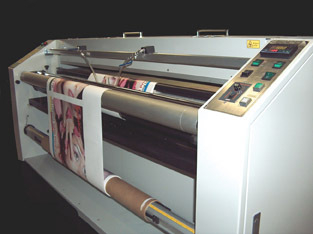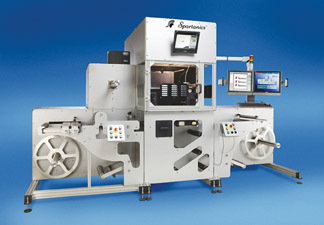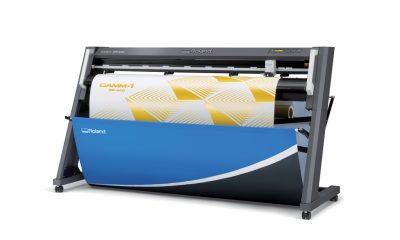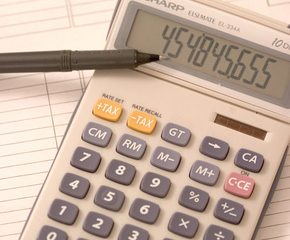Graphics Printing
Published
16 years agoon

The laminator has become a standard piece of finishing equipment for graphics screen printers who have added wide-format inkjets to their imaging arsenals. Its primary purpose is to place a barrier between a printed graphic and the wear it will inevitably experience in use. Laminators in the graphics industry are generally thought of as machines that apply films to protect graphics from the elements, damage from scratches and abrasions, exposure to harsh chemicals, and more. But laminators also can take another form, one in which they apply protective liquid coatings.
The laminator has become a standard piece of finishing equipment for graphics screen printers who have added wide-format inkjets to their imaging arsenals. Its primary purpose is to place a barrier between a printed graphic and the wear it will inevitably experience in use. Laminators in the graphics industry are generally thought of as machines that apply films to protect graphics from the elements, damage from scratches and abrasions, exposure to harsh chemicals, and more. But laminators also can take another form, one in which they apply protective liquid coatings. Liquid laminating technology is the focus of this article, which will look at the equipment, coating types, applications, and benefits associated with this finishing process.
The liquid laminator
The liquid laminator is essentially a coating machine. At the most basic level, printed graphics are loaded in the device, coated, and then unloaded. Intermediate and final steps in the laminating process vary according to the type of coating in use, which can be UV curable, water based, or solvent based. For example, media treated with a UV coating would pass through a curing station before it could be unloaded, while a substrate coated with a water-based formulation, depending on the laminator’s level of automation, many travel the course of an infrared drying chamber to hasten the drying process.
Liquid laminators are available in a variety of configurations and sizes to suit a wide range of applications. Manually operated and automatic units are available, as are flatbed and roll-fed types (Figure 1). UV laminators are typically reverse-roll, three-roll systems. Water-based laminators generally flood-coat the substrate and then employ a Meyer bar, also known as a wire-round metering rod, to reduce the coating’s thickness to the appropriate level. A squeegee or similar device removes the coating from the back side of the substrate.
"It’s not roller coating, it’s actually wiping," says Ike Harris, president of Daige, Inc. "It’s a special rod that’s used in labs when they want precision coating. It’s also used in manual and big roll-to-roll machines to apply water-based coatings. It wipes off the image side and leaves a very smooth, even coating."
Roll coaters use their rolls to share the duty of moving printed graphics along and applying coatings to them. From there, the coated media must either be cured by photoinitiation (UV), by heat such as infrared drying, or by air drying, which takes the longest amount of time. Media transporters, often in the form of conveyors, are integrated into some models to carry freshly coated substrates to the drying or curing systems. As an alternative, graphics coated with water-based formulations may be carefully racked horizontally and allowed to dry. This approach is usually reserved for manual coaters. Harris says water-based coatings can air dry in 20-25 min.
Some of the recently introduced UV liquid laminators are able to cure at high speeds, sometimes at more than 100 ft/ min. They also can be designed with very conservative footprints. For example, the total length of such a machine may be less than 5 feet, including the conveyor, because the machine is able to process so much substrate so quickly.
The nature of the jobs and the quantities you accept ultimately dictate the type of liquid laminator you’ll need. If you print lots of banner graphics on scrim vinyl, or P-O-P images on fabrics, you may be better off with a water-based coating system. That’s because the material’s printed surface is covered in valleys that must be filled with the liquid coating for the lamination to be effective.
According to Jim Tatum, president of Advanced Finishing Solutions, running such textured materials through a UV liquid laminator isn’t the best idea because the machines lay down a thin coating layer at very high speeds. He says that given those operating parameters, the coating will never have the chance to fall into the depressions in the substrate’s surface.
“What happens is you get graphics that are partially coated and cured. That’s not going to do you well in bad weather and other elements that would cause the coating to get weak where it bonds,” Tatum notes. On the other hand, a waterbased liquid laminator would flood the textured substrate with coating, thereby ensuring that all of the valleys are properly covered.
Protective coatings and their applications
UV coatings have quickly gained popularity in recent years as printers explore production and finishing options that are more environmentally friendly. UV coatings for printed graphics are made without the use of VOCs. They’re composed entirely of convertible solids, meaning they become plastic with nothing evaporating in the process. Water-based coatings, which are often composed of 70% water and 30% resins, take longer to set because the water content must be allowed to evaporate completely before the substrates can be rolled or stacked. Tatum says the evaporation factor adds to the cost of using water-based coatings.
“To get the same type of coverage rate [as UV], you have to put a lot more on; hence, you’re spending more money,” Tatum explains. “The benefit of UV is it works with a reverse-roll coater, a three-roll coating system. It lays down the coating in a very, very thin layer, from about 6-20 microns.”
Water-based coatings have benefited recently from advances in formulation technologies. Just a few years ago, you could find 2-3 lb/gal of VOCs in a water-based coating. Today, some coatings are made with less than a pound per gallon. Tatum explains that high VOC content was one of the main contributors to yellowing. He credits the use of non-stearated resins for the reduction in solvent content in aqueous coatings.
Despite the gains made by waterbased and UV-curable coatings, solventbased formulations still have a place in liquid lamination. David Conrad, equipment product manager for Neschen Americas, says solvent coatings remain prevalent in the sign industry. Flexible displays benefit from solvent coatings, which are designed to resist becoming brittle or cracking with age. He says applications on rigid media are best suited to UV coatings. That’s because UV coatings typically don’t exhibit the same elongation properties found in other types of coatings. And for that reason, as Tatum puts it, UV coatings don’t fit the bill for protecting fleet graphics and vehicle wraps (Figure 2).
“At the very minimum, you should have about 150% elongation to qualify for a proper fleet type of product, because it needs to go around rivets, around intricate curves, and so on, without causing the coating to break,” Tatum explains. “Once the coating breaks, then your ink is toast.”
As a general rule of thumb, any substrate that is demanding in terms of coverage requirements or flexibility in end use may be better matched up with water- or solvent-based coatings. Also keep in mind that the high solids content of UV coatings can inhibit the soft hand of fabrics and other specialty media. Speaking of which, those who use inkjet printers to produce fine art (giclée) or photographic works on canvas should take special note of the requirements for protecting that family of media with a liquid laminator.
“If you’re printing on an aqueous printer like an Epson, Roland, HP, or even Canon—anything with a waterbased ink—then the image requires a liquid laminate on canvas to protect it from bleeding and also to give it some UV protection,” says Jim Manelski, president of BullDog Products. “Having said that, there are within the aqueous printers two types of canvas that can be used and two different flavors of coatings that go on the canvas, depending on the type.”
A water-resist type of canvas calls for an aqueous coating. This kind of canvas is designed to absorb a lot of ink and is therefore less subject to bleeding. Manelski notes that short-term applications on water-resist canvas may survive short-term display without liquid lamination, though any measurable longevity requires coating.
The other kind of canvas, called swellable, needs a solvent-based top coating. That’s because the inks tend to sit on the substrate’s surface and are more susceptible to bleeding from moisture until protected. Swellable canvas can be more prone to bleeding than its water-resist counterpart, but Manelski says many still prefer swellable canvas because, in most cases, it produces a wider color gamut.
Liquid laminators in general are key to the protection of fine-art prints, according to Manelski, because they greatly reduce the possibility of contaminating the print with dust or other matter. Spraying on a liquid coating, for example, poses the risk of catching airborne particulates and depositing them on a graphic’s surface and permanently locking them in. “There’s a whole lot less of a chance with a liquid laminator, because you’re going dry to dry,” he says.
Other unique applications that benefit from liquid lamination include doors, furnishings, wall coverings, decor, and even food packaging. Giving products like these, as well as graphics intended for more conventional uses, the protection they need means you’ll have to carefully pair them up with the appropriate coating formulation. Let’s take a look at effective ways to match up coatings and prints.
Selecting the right liquid
It’s no secret that exposure to ultraviolet light cures UV inks and coatings, but it’s that property that prevents UV-curable liquid laminates from offering graphics protection from sun damage. Any sort of UV inhibitor would prevent the coatings from curing. Therefore, the primary purpose of UV liquid laminates is to shield printed graphics from scratching and abrasion. Tatum notes that UV-curable coatings work very well on graphics produced on UV inkjet printers. He says in most cases water-based coatings don’t work as well on UV inkjet prints because cured UV inks tend to act as non-stick surfaces.
Harris advises those who print solvent or eco-solvent inks to use waterbased liquid laminates. He says the basic rule to follow is to reverse the coating— for example, to use a water-based coating on a solvent inkjet print, and vice versa. “And when you’re using water-based coating on outdoor media, like vinyl, it tends to get absorbed a lot easier because of the precoat on the media. Although it won’t run the inks, it won’t give as good protection as it would on uncoated media you’d use with a solvent inkjet printer,” he explains.
One thing to keep in mind is that water-based liquid laminates, like aqueous screen-printing inks, do contain some solvents. As mentioned earlier, the VOC content of these coatings has dropped over the past few years—even in products designed for stain and graffiti resistance; however, you should make sure to keep an MSDS on site for each water-based coating you use.
Solvent liquid laminates are most often applied to water-based prints. They may be formulated with components that absorb UV light, as well as stabilizers that inhibit polymer degradation caused by photo-oxidation or thermal exposure. Solvent coatings also may contain leveling agents, which promote smoothness in a coating’s surface.
Cost considerations
The cost of using liquid coatings as alternatives to film-based laminates is one of the factors that has brought increased attention to liquids. According to Conrad, protecting graphics with liquid laminates can cost as little as $0.02-0.03/sq ft on applications such as short-term displays and as much as $0.30-0.38/sq ft—or more—on demanding, long-term applications, such as digitally printed wall coverings.
As Harris puts it, “For film laminates, calendared could cost $0.35/sq ft and cast could cost $0.50-0.60/sq ft or more. You have a big cost savings with liquid laminates.”
The price of consumables is but one consideration. Tatum says waste and handling are other details that must not be overlooked.
“Every film-laminated print you do has to be webbed into a laminator, and you can’t get perfectly sized films for each print, because they’re not sold that way. So you’ve got an excessive amount of waste around the print, and that all has to be trimmed, so there’s more labor involved in it,” he explains. “Also, the speed of liquid-laminator operation is much faster. And now you factor in no trimming and no waste—it’s huge.”
Time to give it a shot?
Conrad says lamination in general is still primarily the domain of inkjet printing. But now that digital imaging technology has become a fixture in many screen shops, the time may be right for you to explore solutions for protecting the graphics you produce on your wide-format inkjet printers. The price of buying largely depends on the type of liquid laminator. UV systems are typically more costly up front than those that apply water-based coatings, basically because they use UV-curing lamps and are configured to process printed substrates very quickly. In some cases, a UV coater may be just slightly less expensive than a water-based system five times its width.
“The cost of entry is a lot less painful in water-based coating systems; however, once you eat that pain, so to speak, to get into a UV system, the speed, cost of coating, stackability—all of those benefits are on the UV side. The only negative is that the UV coatings are not going to be as flexible as water-based coatings,” Tatum says.
The ultimate goal remains the same, regardless of which type of laminator you select: to guard your digitally printed graphics. Investing in this technology will put you in a better position to protect your bottom line, defend your position in a competitive market, and seal deals with new clients.
Sources for Liquid Laminators and Coatings
Advanced Finishing Solutions
1939 Tate Blvd. SE
Hickory, NC 28602
888-649-4666
Web: www.advfinishing.com
BullDog Products, Inc.
15368 El Prado Rd.
Chino, CA 91710
800-579-8964
Web: www.bulldogproducts.com
Daige, Inc.
1 Albertson Ave.
Albertson, NY 11507
800-645-3323
fax: 516-621-1916
Web: www.daige.com
H&H Digital Products
1724 Elmhurst Rd.
Elk Grove Village, IL 60007
847-952-3247
fax: 847-228-1689
Web: www.hhdigitalproducts.net
Keundo
Keundo Bldg.
726-1, Yoksam-dong
Gangnam-gu, Seoul, 135-080
Korea
82-2-552-1946
fax. 82-2-552-7145
e-mail. keundo@keundo.com
Web: www.keundo.com
Lumina Coatings Intl.
3843F 44 Ave.
Camrose, Alberta T4V 3T1
Canada
780-672-1077
fax: 866-220-6438
Web: www.luminacoatingsintl.com
Neschen Americas
7091 Troy Hill Dr.
Elkridge, MD 21075
410-379-5400
fax: 410-579-8960
Web: www.neschenamericas.com
Optima Int’l
1291 High St. Ste. J
Denver, CO 80218
720-434-4063
Web: www.optima-int.com

Subscribe

Magazine
Get the most important news
and business ideas from Screenprinting Magazine.
Most Popular
-

 Case Studies2 months ago
Case Studies2 months agoHigh-Density Inks Help Specialty Printing Take Center Stage
-

 Art, Ad, or Alchemy2 months ago
Art, Ad, or Alchemy2 months agoF&I Printing Is Everywhere!
-

 Andy MacDougall2 months ago
Andy MacDougall2 months agoFunctional and Industrial Printing is EVERYWHERE!
-

 Columns3 weeks ago
Columns3 weeks ago8 Marketing Mistakes Not to Make When Promoting Your Screen Printing Services Online
-

 Editor's Note2 weeks ago
Editor's Note2 weeks agoLivin’ the High Life
-

 Marshall Atkinson2 weeks ago
Marshall Atkinson2 weeks agoHow to Create a Winning Culture in Your Screen-Printing Business
-

 Thomas Trimingham2 months ago
Thomas Trimingham2 months ago“Magic” Marketing for Screen Printing Shops
-

 News & Trends2 months ago
News & Trends2 months agoWhat Are ZALPHAS and How Can You Serve Them in Your Print Business?






